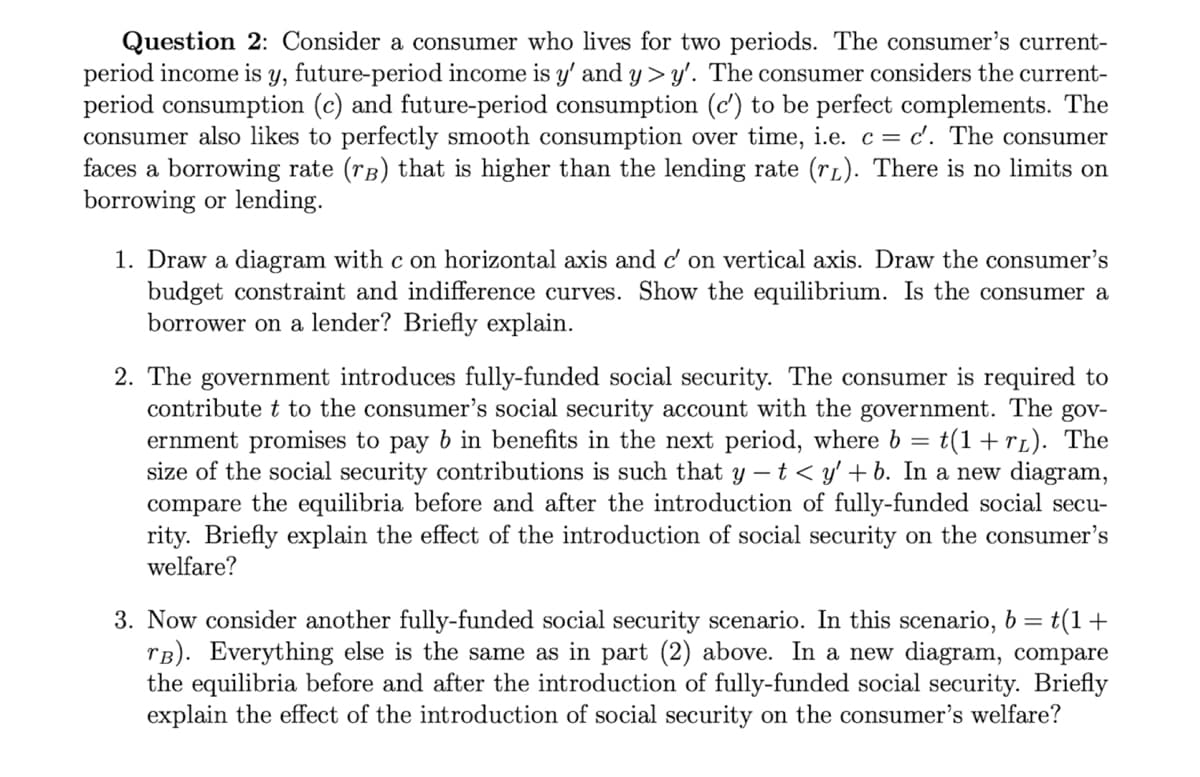Question 2: Consider a consumer who lives for two periods. The consumer's current- period income is y, future-period income is y' and y> y'. The consumer considers the current- period consumption (c) and future-period consumption (c') to be perfect complements. The consumer also likes to perfectly smooth consumption over time, i.e. c = c'. The consumer faces a borrowing rate (TB) that is higher than the lending rate (r). There is no limits on borrowing or lending. 1. Draw a diagram with c on horizontal axis and c' on vertical axis. Draw the consumer's budget constraint and indifference curves. Show the equilibrium. Is the consumer a borrower on a lender? Briefly explain. 2. The government introduces fully-funded social security. The consumer is required to contribute t to the consumer's social security account with the government. The gov- +(1 m) TL
Question 2: Consider a consumer who lives for two periods. The consumer's current- period income is y, future-period income is y' and y> y'. The consumer considers the current- period consumption (c) and future-period consumption (c') to be perfect complements. The consumer also likes to perfectly smooth consumption over time, i.e. c = c'. The consumer faces a borrowing rate (TB) that is higher than the lending rate (r). There is no limits on borrowing or lending. 1. Draw a diagram with c on horizontal axis and c' on vertical axis. Draw the consumer's budget constraint and indifference curves. Show the equilibrium. Is the consumer a borrower on a lender? Briefly explain. 2. The government introduces fully-funded social security. The consumer is required to contribute t to the consumer's social security account with the government. The gov- +(1 m) TL
Chapter1: Making Economics Decisions
Section: Chapter Questions
Problem 1QTC
Related questions
Question

Transcribed Image Text:Question 2: Consider a consumer who lives for two periods. The consumer's current-
period income is y, future-period income is y' and y> y'. The consumer considers the current-
period consumption (c) and future-period consumption (c') to be perfect complements. The
consumer also likes to perfectly smooth consumption over time, i.e. c = c'. The consumer
faces a borrowing rate (r) that is higher than the lending rate (r). There is no limits on
borrowing or lending.
1. Draw a diagram with c on horizontal axis and c' on vertical axis. Draw the consumer's
budget constraint and indifference curves. Show the equilibrium. Is the consumer a
borrower on a lender? Briefly explain.
2. The government introduces fully-funded social security. The consumer is required to
contribute t to the consumer's social security account with the government. The gov-
ernment promises to pay b in benefits in the next period, where b = t(1+r). The
size of the social security contributions is such that y − t <y' + b. In a new diagram,
compare the equilibria before and after the introduction of fully-funded social secu-
rity. Briefly explain the effect of the introduction of social security on the consumer's
welfare?
3. Now consider another fully-funded social security scenario. In this scenario, b = t(1 +
TB). Everything else is the same as in part (2) above. In a new diagram, compare
the equilibria before and after the introduction of fully-funded social security. Briefly
explain the effect of the introduction of social security on the consumer's welfare?
Expert Solution
This question has been solved!
Explore an expertly crafted, step-by-step solution for a thorough understanding of key concepts.
This is a popular solution!
Trending now
This is a popular solution!
Step by step
Solved in 4 steps with 2 images

Knowledge Booster
Learn more about
Need a deep-dive on the concept behind this application? Look no further. Learn more about this topic, economics and related others by exploring similar questions and additional content below.Recommended textbooks for you


Principles of Economics (12th Edition)
Economics
ISBN:
9780134078779
Author:
Karl E. Case, Ray C. Fair, Sharon E. Oster
Publisher:
PEARSON

Engineering Economy (17th Edition)
Economics
ISBN:
9780134870069
Author:
William G. Sullivan, Elin M. Wicks, C. Patrick Koelling
Publisher:
PEARSON


Principles of Economics (12th Edition)
Economics
ISBN:
9780134078779
Author:
Karl E. Case, Ray C. Fair, Sharon E. Oster
Publisher:
PEARSON

Engineering Economy (17th Edition)
Economics
ISBN:
9780134870069
Author:
William G. Sullivan, Elin M. Wicks, C. Patrick Koelling
Publisher:
PEARSON

Principles of Economics (MindTap Course List)
Economics
ISBN:
9781305585126
Author:
N. Gregory Mankiw
Publisher:
Cengage Learning

Managerial Economics: A Problem Solving Approach
Economics
ISBN:
9781337106665
Author:
Luke M. Froeb, Brian T. McCann, Michael R. Ward, Mike Shor
Publisher:
Cengage Learning

Managerial Economics & Business Strategy (Mcgraw-…
Economics
ISBN:
9781259290619
Author:
Michael Baye, Jeff Prince
Publisher:
McGraw-Hill Education